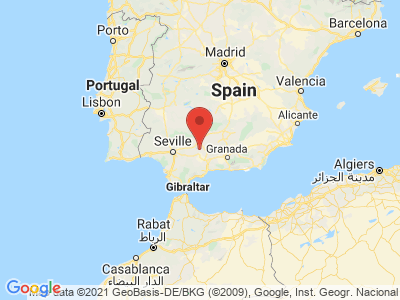Climate Table Andalusien
Jan | Feb | Mar | Apr | May | Jun | Jul | Aug | Sep | Oct | Nov | Dec | |
|---|---|---|---|---|---|---|---|---|---|---|---|---|
| Max. Temperature | 17° | 17° | 18° | 21° | 23° | 27° | 29° | 30° | 27° | 23° | 20° | 17° |
| Min. Temperature | 8° | 9° | 11° | 13° | 15° | 19° | 21° | 22° | 20° | 16° | 12° | 10° |
| Sun Hours | 6 | 6 | 6 | 8 | 10 | 11 | 12 | 11 | 9 | 7 | 6 | 6 |
| Water Temperature | 15° | 14° | 14° | 15° | 17° | 19° | 21° | 22° | 21° | 19° | 17° | 16° |
| Rain Days | 7 | 6 | 7 | 6 | 4 | 1 | 0 | 1 | 2 | 6 | 7 | 8 |
The climate year of Andalusia
In general, the climate throughout Andalusia is mild and dry, with significant temperature differences between the coasts and inland. The Costa del Sol is hotter than the Costa de la Luz in western Andalusia, with temperatures of up to 40 °C in summer. Here, the Atlantic provides a fresh breeze and perfect surfing conditions, while on the more sheltered Mediterranean beaches, water temperatures of 19 °C are inviting for swimming. The climatic conditions in the mountain ranges of Andalusia are harsher. On the heights of the Sierra Nevada one can still expect snow in spring and in the northeastern Sierra de Grazalema rain showers in summer. Spring and autumn are suitable for city tours and active vacations. From March to June, temperatures are mild but less physically demanding than in the hot summer months. From mid-September, hiking activities in the national parks offer relaxation and nature experiences.
General information about Andalusia
Andalusia is a popular vacation destination for sun worshippers in the summer because of its bathing bays and sailing ports. Those interested in culture will find stone witnesses of history from Malaga to Seville and from Gibraltar to Cordoba. The legendary Alhambra in Granada is a relic of the Moorish period. In gardens and parks, tile mosaics recall the time of the Arab rulers. Churches and palaces from the time of the Christian dynasties offer architectural masterpieces and art treasures. Hikers and nature lovers can discover scenic attractions of 32 national parks, including the Sierra Nevada and the Donana Natural Park on the Costa de la Luz. A drive through the inland mountains to the canyon town of Ronda offers stunning views.
Tourism Andalusia
The mild climate Andalusia is reflected in the number of hours of sunshine, which in the winter months is 5 to 6 hours daily. From June to August, the sun shines about 12 hours a day. The average daytime temperatures vary from 12 °C in January and December to 36 °C in summer, depending on the region. At night, even in summer, it can get quite chilly. Water temperatures on the Costa del Sol rarely drop below 15 °C throughout the year, peaking at an average of 19 °C from June to October. This is the best time to travel for a beach vacation, with daytime temperatures reaching tropical proportions with peaks of up to 40 °C. From March to May it is pleasantly warm with an average of 20 °C. From October on, it gets cooler in Andalusia and rain can set in.


